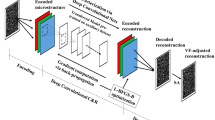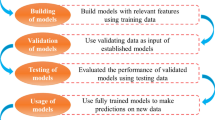Abstract
Modern materials design requires reliable and consistent structure–property relationships. The paper addresses the need through transfer learning of deep material network (DMN). In the proposed learning strategy, we store the knowledge of a pre-trained network and reuse it to generate the initial structure for a new material via a naive approach. Significant improvements in the training accuracy and learning convergence are attained. Since all the databases share the same base network structure, their fitting parameters can be interpolated to seamlessly create intermediate databases. The new transferred models are shown to outperform the analytical micromechanics methods in predicting the volume fraction effects. We then apply the unified DMN databases to the design of failure properties, where the failure criteria are defined upon the distribution of microscale plastic strains. The Pareto frontier of toughness and ultimate tensile strength is extracted from a large-scale design space enabled by the efficiency of DMN extrapolation.











Similar content being viewed by others
References
Olson GB (1997) Computational design of hierarchically structured materials. Science 277(5330):1237–1242
Panchal JH, Kalidindi SR, McDowell DL (2013) Key computational modeling issues in integrated computational materials engineering. Comput Aided Des 45(1):4–25
McVeigh C, Vernerey F, Liu WK, Brinson LC (2006) Multiresolution analysis for material design. Comput Methods Appl Mech Eng 195(37):5053–5076
Buljac A, Jailin C, Mendoza A, Neggers J, Taillandier-Thomas T, Bouterf A, Smaniotto B, Hild F, Roux S (2018) Digital volume correlation: review of progress and challenges. Exp Mech 58(5):661–708
Hill R (1963) Elastic properties of reinforced solids: some theoretical principles. J Mech Phys Solids 11(5):357–372
Feyel F, Chaboche JL (2000) FE2 multiscale approach for modelling the elastoviscoplastic behaviour of long fibre SIC/TI composite materials. Comput Methods Appl Mech Eng 183(3):309–330
Wu CT, Koishi M (2012) Three-dimensional meshfree-enriched finite element formulation for micromechanical hyperelastic modeling of particulate rubber composites. Int J Numer Methods Eng 91(11):1137–1157
Wu CT, Guo Y, Askari E (2013) Numerical modeling of composite solids using an immersed meshfree Galerkin method. Compos Part B Eng 45(1):1397–1413
Moulinec H, Suquet P (1998) A numerical method for computing the overall response of nonlinear composites with complex microstructure. Comput Methods Appl Mech Eng 157(1–2):69–94
De Geus T, Vondřejc J, Zeman J, Peerlings R, Geers M (2017) Finite strain FFT-based non-linear solvers made simple. Comput Methods Appl Mech Eng 318:412–430
Yvonnet J, Monteiro E, He QC (2013) Computational homogenization method and reduced database model for hyperelastic heterogeneous structures. Int J Multiscale Comput Eng 11(3):201–225
Yang Z, Yabansu YC, Al-Bahrani R, Liao Wk, Choudhary AN, Kalidindi SR, Agrawal A (2018) Deep learning approaches for mining structure–property linkages in high contrast composites from simulation datasets. Comput Mater Sci 151:278–287
Bessa M, Bostanabad R, Liu Z, Hu A, Apley D, Brinson C, Chen W, Liu W (2017) A framework for data-driven analysis of materials under uncertainty: countering the curse of dimensionality. Computer Methods Appl Mech Eng 320:633–667
Raissi M, Karniadakis GE (2018) Hidden physics models: machine learning of nonlinear partial differential equations. J Comput Phys 357:125–141
Chen Z, Huang T, Shao Y, Li Y, Xu H, Avery K, Zeng D, Chen W, Su X (2018) Multiscale finite element modeling of sheet molding compound (smc) composite structure based on stochastic mesostructure reconstruction. Compos Struct 188:25–38
Oliver J, Caicedo M, Huespe A, Hernández J, Roubin E (2017) Reduced order modeling strategies for computational multiscale fracture. Computer Methods Appl Mech Eng 313:560–595
Kalidindi SR (2015) Hierarchical materials informatics: novel analytics for materials data. Elsevier, Amsterdam
Latypov MI, Toth LS, Kalidindi SR (2019) Materials knowledge system for nonlinear composites. Computer Methods Appl Mech Eng 346:180–196
Liu Z, Bessa M, Liu WK (2016) Self-consistent clustering analysis: an efficient multi-scale scheme for inelastic heterogeneous materials. Computer Methods Appl Mech Eng 306:319–341
Liu Z, Fleming M, Liu WK (2018) Microstructural material database for self-consistent clustering analysis of elastoplastic strain softening materials. Computer Methods Appl Mech Eng 330:547–577
Liu Z, Kafka OL, Yu C, Liu WK (2018) Data-driven self-consistent clustering analysis of heterogeneous materials with crystal plasticity. In: Advances in computational plasticity. Springer, pp 221–242
Yu C, Kafka OL, Liu WK (2019) Self-consistent clustering analysis for multiscale modeling at finite strains. Computer Methods Appl Mech Eng 349:339–359
Liu Z, Wu C, Koishi M (2019) A deep material network for multiscale topology learning and accelerated nonlinear modeling of heterogeneous materials. Computer Methods Appl Mech Eng 345:1138–1168
Liu Z, Wu C (2019) Exploring the 3d architectures of deep material network in data-driven multiscale mechanics. J Mech Phys Solids 127:20–46
Thrun S (1996) Is learning the n-th thing any easier than learning the first? In: Advances in neural information processing systems, pp 640–646
Raina R, Ng AY, Koller D (2006) Constructing informative priors using transfer learning. In: Proceedings of the 23rd international conference on machine learning. ACM, pp 713–720
Lubbers N, Lookman T, Barros K (2017) Inferring low-dimensional microstructure representations using convolutional neural networks. Phys Rev E 96(5):052111
Simonyan K, Zisserman A (2014) Very deep convolutional networks for large-scale image recognition. arXiv preprint arXiv:1409.1556
Li X, Zhang Y, Zhao H, Burkhart C, Brinson LC, Chen W (2018) A transfer learning approach for microstructure reconstruction and structure–property predictions. Sci Rep 8(1):13461
Melro A, Camanho P, Pinho S (2008) Generation of random distribution of fibres in long-fibre reinforced composites. Compos Sci Technol 68(9):2092–2102
Mori T, Tanaka K (1973) Average stress in matrix and average elastic energy of materials with misfitting inclusions. Acta Metall 21(5):571–574
Hill R (1965) A self-consistent mechanics of composite materials. J Mech Phys Solids 13(4):213–222
Eshelby JD (1957) The determination of the elastic field of an ellipsoidal inclusion, and related problems. Proc R Soc Lond A 241(1226):376–396
Christensen R, Lo K (1979) Solutions for effective shear properties in three phase sphere and cylinder models. J Mech Phys Solids 27(4):315–330
Acknowledgements
The authors give warmly thanks to Dr. John O. Hallquist of LSTC for his support to this research. The support from the Yokohama Rubber Co., LTD under the Yosemite project is also gratefully acknowledged.
Author information
Authors and Affiliations
Corresponding author
Additional information
Publisher's Note
Springer Nature remains neutral with regard to jurisdictional claims in published maps and institutional affiliations.
Appendices
Appendix A: Analytical solutions of 2D building block
The 2D DMN framework is originally proposed in our previous work [23]. Analytical solutions are available for the two-layer structure shown in the dashed box within Fig. 1, which are derived based on the equilibrium condition
and kinematic constraint
with direction 1 tangential to the interface between the two materials and direction 2 orthogonal to direction 1. Expressions of the components in the compliance matrix \(\bar{\mathbf{D }}^r\) after the homogenization operations are
where
After the homogenization operation, the two-layer structure is rotated. The matrix \(\mathbf R \) defines the rotation of a second-order tensor through the angle \(\theta \) under Mandel notation,
After the rotation operation, the new compliance matrix \(\bar{\mathbf{D }}\) is obtained as
In the global network structure, it will become the input of another building block in the upper level.
Similarly, the analytical forms of the residual strain \(\delta \bar{\varvec{\varepsilon }}^r\) after the homogenization operation are
The overall residual strain \(\delta \bar{\varvec{\varepsilon }}\) after the rotation operation is given by
Appendix B: Design of experiments for DMN training
For the two-phase RVE, the elastic compliance matrices of the two materials are denoted by \(\mathbf D ^{p1}\) and \( \mathbf D ^{p2}\). Both materials are assumed to be orthotropic linear elastic during the sampling. Therefore, each material has four independent design variables: \(E_{11}\), \(E_{22}\), \(\nu _{12}\) and \(G_{12}\). The compliance matrices in Mandel notation can be expressed as
and
To remove the redundancy due to the scaling effect, we have
The other variables are selected randomly as
where U represents the uniform distribution. The Poisson’s ratios are selected to guarantee that the compliance matrices are always positive definite,
Design of experiments are performed based on the Monte Carlo sampling.
Rights and permissions
About this article
Cite this article
Liu, Z., Wu, C.T. & Koishi, M. Transfer learning of deep material network for seamless structure–property predictions. Comput Mech 64, 451–465 (2019). https://doi.org/10.1007/s00466-019-01704-4
Received:
Accepted:
Published:
Issue Date:
DOI: https://doi.org/10.1007/s00466-019-01704-4




